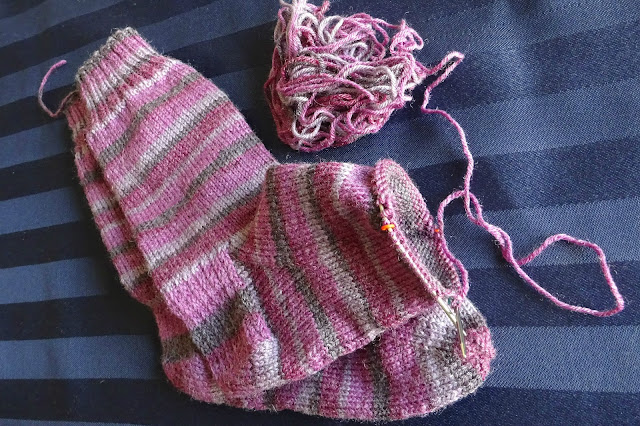The second of the Viola coloured socks has been all but finished for about five days now. But I have been on the road and there wasn´t enough knitting left on them to fill our travelling time. So this latest pair stayed home.
 |
| Just a few more decreases, the Kitchener stitch and Viola #2 is complete. |
Seattle was our destination, well really it was about 1.5 hours south of Seattle at a fairgrounds in Chehalis, Washington. There was a cat show there and it was a good idea to attend. We are looking for at least one and perhaps two kittens and what better place to meet people face to face, see their breeds and talk to experts. It was a fruitful trip. (Paul has bumped into one scammer already trying to sell kittens on the Web, so to see sellers and talk to them seems less risky than relying on the internet alone.)
Rather than take a sock that is all but finished on the trip, I looked for a project to use this yarn.
 |
| The colours are gray, white and black |
It is called Ares from Yarnia in Portland, Oregon. (This is the shop that blends different colours and fiber contents together.) Ares is made up of 40% merino, 40% wool/nylon and 20% cotton. I suspect when I purchased it I thought I would be making a pair of socks with it; the fiber content is appropriate for such use. But without it being plied (all Yarnia yarn comes without the benefit of plying) I suspect the socks would not hold up very long when used. Additionally, the yarn is not superwash, thus the socks would have to be handwashed. This is not great if you are thinking of giving the socks away. So I looked for a lace shawl/scarf pattern that would use all 422 yards of this yarn.
I knew I wanted something that could be used as a scarf in the winter and as a shawl in the summer. (Again that wool and cotton blend would allow this to be sensible.) This wish to have a versatile end product eliminated those patterns that make a dense fabric. I thought lace would open up the fabric but too many of the patterns I found on Ravelry did not include a chart for knitting the lace and I find following written instructions too tedious. (I know it is not difficult to use software to convert written instructions to a chart, but I was in a bit of a hurry.) Then I saw this:
 |
| Photo: © lorelostintheusa |
Yes, yes I know it looks much like the
Clapotis, Tena knit last spring and the two
Dummy Claps I knit last summer, but this does have a twist. It requires some attention, yet is not nearly as demanding as lace or the Clapotis. It is called a Clapo-ktus and is found on Ravelry
here. Unlike the Dummy Clap, this shawl/scarf will have a V-shape formed by increasing one stitch on each right-side rows until the mid-point is reached and then decreasing one stitch on the right side to completion.
The name tells you what to expect. It will have the light and open airiness of the Clapotis with its dropped stitches, and Baktus means the knitter will be able to use the exact amount of yarn available in knitting the the characteristic triangle shape. This is possible because the yarn is weighted and when it is 50% gone the decreasing begins. (Baktus is a character out of Norwegian children stories and this type of scarf was all the rage in Norway a few years back.) By combining the French versatile and open Clapotis with the precision of yarn use in the Baktus one ends up with, IMHO, a pleasing V-shaped fabric.
 |
| As always with these dropped stitch projects, the magic doesn´t begin until you start dropping those stitches. I am not there yet. |
I am about one-third done here. When another .75 ounce of yarn is knit, the half-way mark will be met and decreasing will begin. This mindless knitting has been perfect for traveling and looking up to enjoy the sunshine we have had the last few days.
 |
| Yarn for my next pair of socks |
I have to admit though I am getting an urge to start another pair of socks, using this Serenity sock weight, superwash yarn in the colourway called Chili. The pinks, maroons, greens, blues and cream will make up a clearly woman's pair of socks. The big decision will be whether I decide to knit them cuff down or toe up. More in the next post.




Comments
Post a Comment